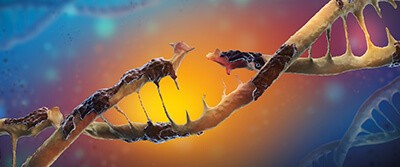Expanding the Toolkit to Repair Gene Mutations

By Kylie Wolfe
New CRISPR technology is changing the way scientists fix DNA mutations. Instead of splicing multi-base sections, they now have the opportunity to edit one base at a time. This technology gives scientists the potential to correct simple genetic mutations, hundreds of which take place in our body each day. While most are harmless, 32,000 disease-associated mutations have been identified.
Our Genetic Code
Our genes are spelled out like instructions that tell our body’s cells what to do. There are four DNA bases that contribute to our genetic code known as adenine (A), cytosine (C), thymine (T), and guanine (G). A pairs with T, and G with C across DNA’s double-stranded helix to form rungs like a ladder. RNA also has four bases, all of which are the same as in DNA except for T, which is replaced by uracil (U).
New Base Editing Technology
CRISPR technology, which is short for Clustered Regularly Interspaced Short Palindromic Repeats, is used to edit DNA by locating palindromic base sequences. A version of this technology was developed in 2016 based on CRISPR/Cas9 that allows researchers to change G and C pairs into A and T using targeting enzymes that alter the base’s chemical structure. A newer version uses a base editor known as TadA attached to Cas9, which yields the ability to do the opposite — changing A and T pairs into G and C pairs. Previous base editors were only able to change C into T, limiting the tool’s abilities. This most recent development, which is known as ABE, has proven to be successful in roughly 50 percent of human cells.
A second study redesigned a gene editor called CRISPR/Cas13 to grasp strands of RNA instead of splicing them. To resolve mutations, researchers attached an enzyme that naturally changes A into inosine (I), which is read as G. Other naturally occurring enzymes in RNA can reverse mutations that turn G and C pairs into A and T.
Scientists are now able to rewrite all bases found in DNA and RNA — and with such advancements in gene editing, researchers plan to further explore potential human applications. So far, scientists have applied this knowledge to human cells and managed to correct a mutation linked to blood disorders. By allowing for fewer unwanted changes at off-target sites, these new and improved editors are proving safer than traditional splicing.
Discussion Questions
- Discuss the pros and cons of base editors and the new versions that have been developed.
- How can DNA mutations alter protein production? Apply what you know about transcription and translation including the terms amino acid, codon, base, mRNA and tRNA.
Vocabulary
- DNA
- Base Pair
- Base Editor
- Enzyme
- Mutation

